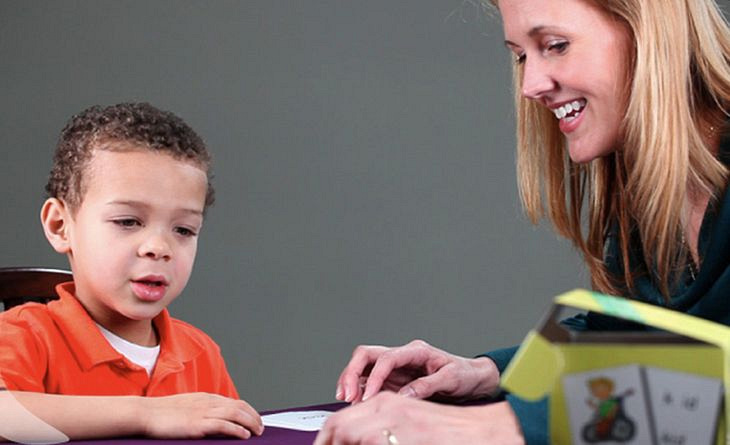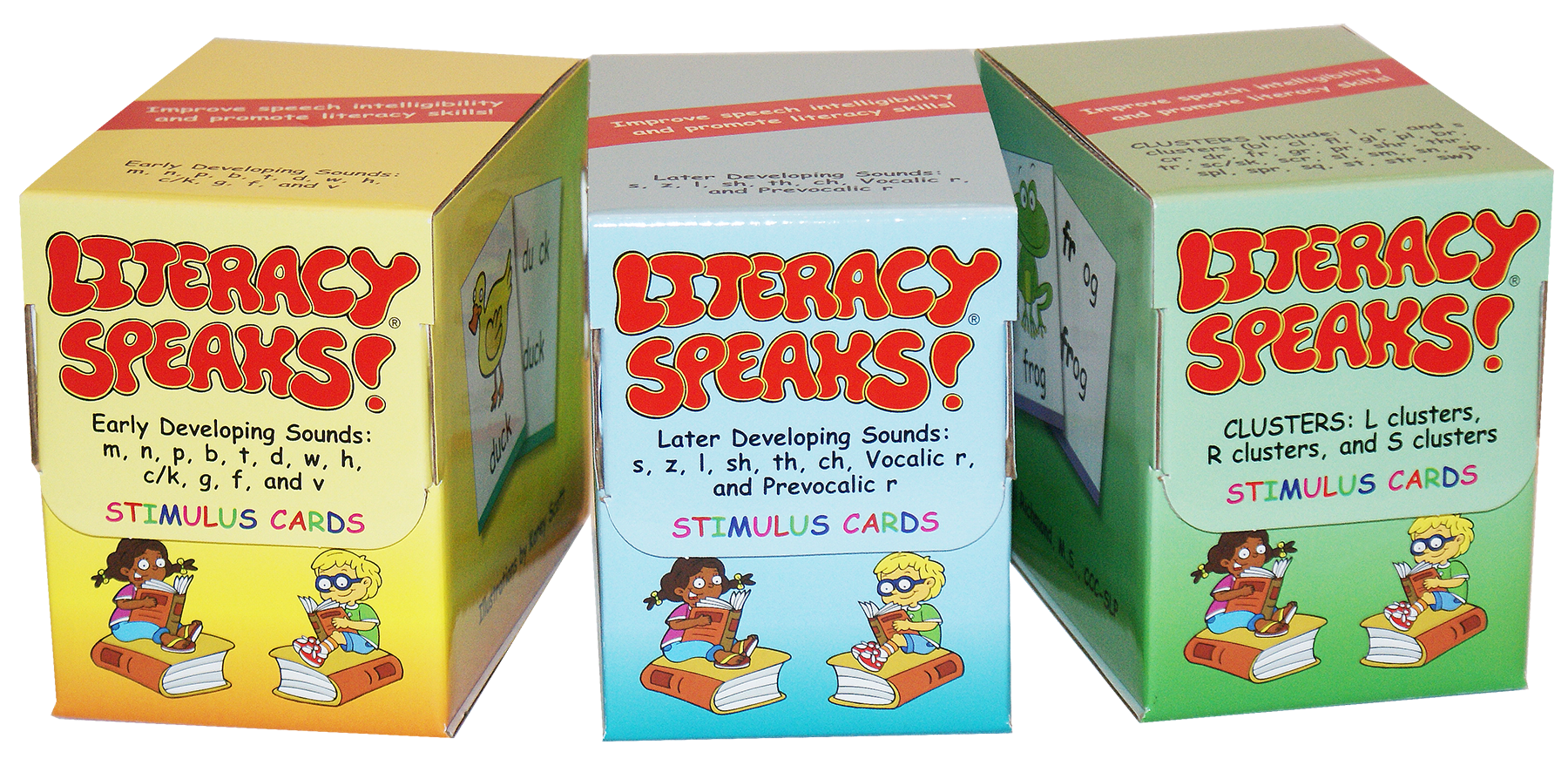Speech Sound Disorders and Early Literacy
As SLPs, we target sound productions and strengthen a child’s expressive skills. However, might we be leaving behind unintentionally a weak underlying phonological system which could contribute to future language and literacy difficulties?
Research has found that even when children with speech sound disorders receive early speech intervention and sounds are successfully remediated, they may be at continued risk for later reading, spelling, and academic difficulties.
How then, can we address underlying phonological representations without sacrificing the time needed to address speech intelligibility?
Traditional vs. Orthographic Therapy – View Video
Literacy Speaks!® provides children with that “a-ha” moment for phonological awareness.
VIEW THERAPY SETS
VIEW RESEARCH
Early Phonological Awareness and Literacy
Reading is a complex action that involves a proficient development and interplay of multiple skills. Of these skills, early phonological awareness is a powerful indicator of later reading abilities (Gillon, 2018; Hogan et al., 2005; Justice, 2006). Broadly, phonological awareness is the conscious understanding that a spoken language is made up of separate segments of sounds. Amazingly, this powerful skill begins to develop in infancy as babies recognize native speech sounds. Then, many young children use this same skill to develop receptive/expressive language and to self-correct speech errors (Fowler, 1991; Yavas, 1998).
Proficient underlying phonological representations help children develop necessary speech, language, and literacy skills. However, children with speech sound disorders often struggle to develop strong underlying phonological representations (Carroll & Snowling, 2004; Farquharson et al., 2017; Larrivee & Catts, 1999; Nathan et al., 2004; Rvachew et al., 2003; Sutherland & Gillon, 2005, 2007).
Without access to stable phonological representations, these children can struggle to develop adequate phonological awareness. In fact, recent studies suggest that weak underlying phonological representations not only cause reading and spelling disorders but may be a causal factor in some speech sound disorders (Anthony et al., 2011; Bird et al., 1995; Larrivee & Catts, 1999; McNeill et al., 2018; Rvachew et al., 2003; Sutherland & Gillon, 2005, 2007).
Half of children with speech sound disorders struggle to develop proficient reading skills. Of these, fifty to seventy percent will require special education support throughout their formal education. Literacy Speaks!® helps SLPs to address speech and language goals and curriculum standards in one session.
Discharged with a Weak Underlying Phonological System
Whereas atypical errors (i.e., initial consonant deletion, backing) are red flags for deficits in an underlying system, single sound errors may signify hiccups in underlying system development and should not be overlooked (Dodd et al., 2017; Farquharson & Boldini, 2018; Hayiou-Thomas et al., 2017; Preston & Edwards, 2010; Preston et al., 2013; Rvachew, 2007). Additionally, correlations have been found between the severity of a speech sound disorder in preschool and whether sounds continue to be incorrectly produced at the initiation of reading instruction (Gernand & Morgan, 2017; Hayiou- Thomas et al., 2017; Preston et al., 2013).
Because speech and language skills develop before reading and spelling skills, SLPs frequently intervene before other professionals. For children with speech sound disorders, evaluations are completed, goals are set, and interventions are initiated to improve speech intelligibility. Historically, therapy for these children has focused on correct sound productions. Evidence-based techniques are implemented, overall intelligibility improves, and children are dismissed as quickly as possible to ensure their participation in curriculum instruction.
Research has found that even when children with speech sound disorders receive early speech intervention and sounds are successfully remediated, they may be at continued risk for later reading, spelling, and academic difficulties (Anthony et al., 2007; Farquharson, 2015a; Farquharson & Boldini, 2018; McNeill et al., 2018; Nathan et. al, 2004; Raitano et al., 2004). As SLPs, we target sound productions and strengthen a child’s expressive skills but may unintentionally leave behind a weak underlying phonological system. Early intervention is imperative. However, even with efficient and effective remediation, difficulties with literacy and academics may be on the horizon.
As SLPs, we target sound productions to strengthen a child’s expressive skills, but we may unintentionally leave behind a weak underlying phonological system. Using the Literacy Speaks!® approach, phonological misrepresentations can be addressed and corrected.
How can SLPs address underlying phonological representations without sacrificing time needed to address speech intelligibility?
Simple!
Incorporate orthographic instruction into your therapy sessions.
VIEW THERAPY SETS
Orthography Builds Underlying Phonological Representations
Since SLPs are frequently the first professional to intervene, making a few intervention modifications may be the key to turning statistics around. Incorporating literacy-based activities including storybooks into sessions builds some preliteracy and oral language skills. But not enough, and it takes time away from target speech goals.
Incorporating orthography (printed cues) into speech production tasks (phonology) has been found to improve intelligibility while building underlying phonological representations. Specifically, incorporating grapheme-phoneme (letter-sound) correlation work at the isolation level supports phonemic knowledge, the strongest predictor of later reading skills.
Additionally, incorporating orthography has been found to support reading and spelling skills while helping children self-correct speech errors (Gillon, 2000, 2002, 2005; Hulme et al., 2007; Lewis et al., 2018; Ricketts et al., 2009; Rosenthal & Ehri, 2008; Saletta et al., 2016; Sutherland and Gillon 2005, 2007).
Incorporating printed cues (orthography) into speech production tasks (phonology) has been found to improve intelligibility while building underlying phonological representations. Literacy Speaks!® starts with the letter first, which is key for successful outcomes.
Literacy Speaks!®
Literacy Speaks!® uses orthographic instruction (printed cues) to first establish appropriate sound-letter association before picture stimuli are introduced. This natural step-by-step learning progression ensures orthographic and phonological knowledge align to improve intelligibility while building early literacy skills, simultaneously!
Literacy Speaks!® offers a hybrid model that can be implemented independently or used in combination with multiple evidence-based speech interventions during individual, group, and classroom sessions. Includes numerous printables and activities to ease clinician workload and enable skill carryover to home and classroom environments.
Literacy Speaks!® establishes appropriate sound-letter association before picture stimuli are introduced to ensure orthographic and phonological knowledge align.
QUESTIONS?
VIEW THERAPY SETS
Available in 3 Individual Sets
Or, Combo and SAVE 25%
View Set 1 Early Sounds: m, n, p, b, t, d, w, h, c/k, g, f, v
View Set 2 Later Sounds: s, z, l, sh, th, ch, pre/vocalic r
View Set 3 Clusters: L, R, S
View 3-Set Combo & Save 25%
Meet The Author
Keli Richmond, MS, CCC-SLP, is a practicing speech-language pathologist specializing in early literacy development. She has a Teaching License as well as a Master of Science Degree in Speech-Language Pathology, Bachelor of Arts Degrees in both Speech-Language Pathology and Audiology, and a Minor Focus in Special Education. Her career began in the medical field with an emphasis on neurological disorders; then, she continued to expand her experience by providing therapy and promoting literacy skills for preschool through middle school students.
Keli conducts in-service training for school-based personnel, presents continuing education seminars nationwide for Northern Speech Services (NSS), and speaks at Speech-Language-Hearing Conventions, Educator Conferences and related events.
Some highlights of Keli’s career are receiving the “Professional Achievement Award in Recognition of Advancement of Knowledge in Clinical Practice” from the Indiana Speech-Language-Hearing Association (ISHA); the “Award for Continuing Education” (ACE) from the American Speech-Language-Hearing Association (ASHA); and the “Award for Top 100 Websites for Speech-Language Pathologists”. The ISHA award is based on outstanding professional development and community involvement. The ASHA award is based on a commitment to lifelong learning. The Top 100 Websites award is based on the best available websites for anyone with an interest in speech-language pathology.
She was a founding member of the United Way Women’s Initiative. The Women’s Initiative is an organization dedicated to closing educational gaps through early literacy development.
Keli is the author of the Literacy Speaks!® program. Literacy Speaks!® is a comprehensive program driven by orthographic instruction (printed cues) designed to improve speech intelligibility, enhance phonological awareness and expand language skills while establishing a strong literacy foundation.







